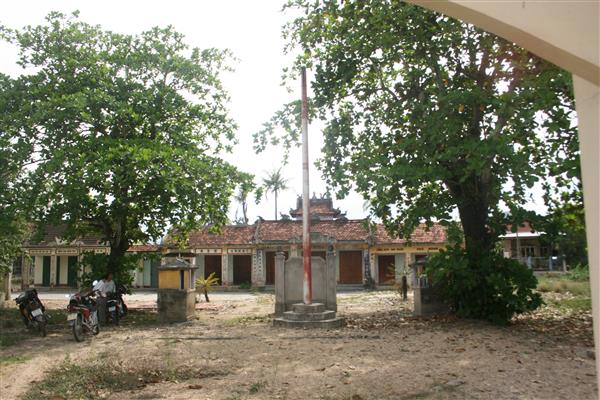Description
Dai Dien Tay communal house is located in Tay 1 village, Dien Son commune, Dien Khanh district, Khanh Hoa province.
Under the reign of King Gia Long in the 12th year (1813), the ancestors after converting the people established a hamlet, Dai An commune consists of 4 villages: Dai Dien Dong, Dai Dien Tay, Dai Dien Nam and Dai Dien Trung (collectively referred to as Dai Dien Trung). Dai Dien Tu hamlet) belongs to Trung Chau canton, Dien Khanh district, Khanh Hoa province. Due to the large number of people and large land, the reclamation work gradually reached the foothills of Dai An, Hon Thap, Hon Ngang, Trang Gang, Trang Ke, Stream Sat, and Line Tra. To facilitate management, Dai An commune is divided into 04 villages for easy management: Dai Dien Dong village, Dai Dien Tay village, Dai Dien Nam village and Dai Dien Trung village. Currently, four villages have merged into 02 communes, Dien Dien and Dien Son. In which, Dien Son commune includes 02 villages: Dai Dien Nam village and Dai Dien Tay village. After dividing the village, Dai An communal house was also divided as follows: Dai Dien Tay village received the east house, Dai Dien Nam village received Tien Hien temple, Dai Dien Dong village received the main hall and Dai Dien Trung village received the sacrifice. The people of Dai Dien Tay village built their village communal house on the land of Mr. Cuu Nam Hon (Commune Chief) around 1884. By 1902, the village's elders found that the communal house was not in the center. of the village should move to build on the land behind Hoa Vong church.
In 1945 - 1946, the French invaders attacked Dai Dien Tu hamlet. Also around this time, Dai Dien Tay communal house was the place to hide weapons, food and food and was the place to hold meetings of the Viet Minh movement to discuss plans against the French, to establish a guerrilla army to fight the French. At the same time, the relic is also a place to study the policies and resolutions of the Party Committee of Khanh Hoa province. After being pointed out by the Vietnamese, the French invaders burned down the entire Dai Dien Tay communal house in 1946, and all the ordinations were burned. In 1958, the people chose the site to rebuild the communal house at the tomb of the Tien Hien, which is the current location of the communal house.


General plan of Dai Dien Tay communal house
The communal house faces the East, has a total land area of 2,650m2. The relic includes the following items: Nghi Mon, Semicircle Lake, Temple of Son Lam Lord General, Temple of Am Co Martyrs, Confucian Court, Pre-Sacrifices, Main Hall, Temple of Tien Hien, Temple of Ba Thien Y A Na, East house and house. tru.
Dai Dien Tay communal house has undergone the following renovations:
- In 1970, Dai Dien Tay communal house was damaged by bombs and bullets, so it was restored.
- In 1975, after the complete liberation of the South and reunification of the Fatherland, due to many difficulties and lack of material facilities of the revolutionary government, Dai Dien Tay communal house was used as a warehouse for storing rice and a school. learn; Dai Dien Tay Temple is used as the Office of the Management Board of Agricultural Cooperatives; East houses are used as trading cooperatives; Tien Hien Temple is used as a rice warehouse.
- In 1994, Dai Dien Tay communal house was renovated.
- In 1997, rebuilt the kitchen and winter house, built a semicircular lake.
- In 2000, paved the entire floor of the communal house, Tien Hien Temple and the East house.
- In 2005, building the subject.
Dai Dien Tay Communal House worships Than Hoang, Thien Y A Na, Son Lam, Tien Hien, Am Co, martyrs, Seniors, and Juniors. The festival is held on the 10th day of the third lunar month every year.
Recognizing the historical - cultural values of the relic, in 2006 Khanh Hoa Provincial People's Committee issued Decision No. 516/QD-UBND ranking Dai Dien Tay communal house as a provincial relic.